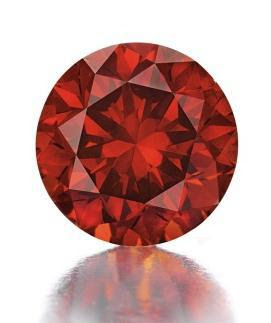 |
| 3.15-carat circular-cut fancy reddish orange diamond. Estimate: $700,000 – 1,200,000. Photo credit: CHRISTIE'S IMAGES LTD. 2012 |
Red is certainly the color of Christmas and in this spirit Christie’s New York is offering a rare red diamond along with a 50-carat D color Graff diamond that could fetch $10 million during its Magnificent Jewels sale on December 10.
The 3.15 carat circular-cut fancy reddish orange diamond is the largest such diamond ever graded by the Gemological Institute of America and the largest ever to be offered at auction. Exhibiting excellent symmetry and polish, this stone is estimated at $700,000 - $1.2 million.
The diamond’s rarity is a function of both its intense color and large size, the auction house said. Very few red diamonds larger than one carat are known to exist. Among the largest is a circular-cut 5.03 fancy dark red diamond that is now in the permanent collection of the Smithsonian Institution in Washington, D.C.
 |
| 50.01-carat Rectangular-cut D-color diamond ring by Graff. Estimate: $7,000,000 – 10,000,000. Photo credit: CHRISTIE'S IMAGES LTD. 2011 |
While impressive, the red diamond will not be the most expensive lot being offered at the daylong auction. That honor goes to a 50.01-carat D color diamond ring by the celebrated jeweler Graff. Offered for sale from an important private collection, the stone is mounted in a platinum setting designed by Graff, with two baguette-cut diamonds flanking the center stone. It’s estimated at $7 million - $10 million.
The Graff diamond is one of 12 D-color diamonds—the whitest shade possible—among the 300 lots being offered at the sale, which also includes rare gemstones, natural pearls and signed jewels from the Art Nouveau and Art Deco periods. The total sale, which is accessible for bidding in person, on the phone, online, or by absentee bid, is expected to realize in excess of $25 million.
 |
| Three-stone Colombian Emerald ring of 8.51, 4.04 and 3.94 carats. Estimate: $475,000 – 550,000. Photo credit: CHRISTIE'S IMAGES LTD. 2011 |
Among the star lots of gemstone jewelry is a three-stone Colombian emerald ring mounted with an 8.51 carat cushion-cut center stone and flanked by matching emeralds of 4.04 and 3.94 carats, respectively. Its estimate is $475,000 - $550,000.
 |
| Sapphire and diamond bracelet by Paul Flato from circa 1935. Photo credit: CHRISTIE'S IMAGES LTD. 2011 |
Among the period pieces being offered is a sapphire and diamond bracelet by American jeweler Paul Flato from circa 1935, which is on the cover of the sale cataloge. Its estimate is $120,000 - 180,000. This jewel, offered from a prominent private collection, is designed as an openwork bracelet with alternating rectangular-cut sapphire and diamond bricklink bands.
 |
| 3.15-carat circular-cut fancy reddish orange diamond. Estimate: $700,000 – 1,200,000. Photo credit: CHRISTIE'S IMAGES LTD. 2012 |
Red is certainly the color of Christmas and in this spirit Christie’s New York is offering a rare red diamond along with a 50-carat D color Graff diamond that could fetch $10 million during its Magnificent Jewels sale on December 10.
The 3.15 carat circular-cut fancy reddish orange diamond is the largest such diamond ever graded by the Gemological Institute of America and the largest ever to be offered at auction. Exhibiting excellent symmetry and polish, this stone is estimated at $700,000 - $1.2 million.
The diamond’s rarity is a function of both its intense color and large size, the auction house said. Very few red diamonds larger than one carat are known to exist. Among the largest is a circular-cut 5.03 fancy dark red diamond that is now in the permanent collection of the Smithsonian Institution in Washington, D.C.
 |
| 50.01-carat Rectangular-cut D-color diamond ring by Graff. Estimate: $7,000,000 – 10,000,000. Photo credit: CHRISTIE'S IMAGES LTD. 2011 |
While impressive, the red diamond will not be the most expensive lot being offered at the daylong auction. That honor goes to a 50.01-carat D color diamond ring by the celebrated jeweler Graff. Offered for sale from an important private collection, the stone is mounted in a platinum setting designed by Graff, with two baguette-cut diamonds flanking the center stone. It’s estimated at $7 million - $10 million.
The Graff diamond is one of 12 D-color diamonds—the whitest shade possible—among the 300 lots being offered at the sale, which also includes rare gemstones, natural pearls and signed jewels from the Art Nouveau and Art Deco periods. The total sale, which is accessible for bidding in person, on the phone, online, or by absentee bid, is expected to realize in excess of $25 million.
 |
| Three-stone Colombian Emerald ring of 8.51, 4.04 and 3.94 carats. Estimate: $475,000 – 550,000. Photo credit: CHRISTIE'S IMAGES LTD. 2011 |
Among the star lots of gemstone jewelry is a three-stone Colombian emerald ring mounted with an 8.51 carat cushion-cut center stone and flanked by matching emeralds of 4.04 and 3.94 carats, respectively. Its estimate is $475,000 - $550,000.
 |
| Sapphire and diamond bracelet by Paul Flato from circa 1935. Photo credit: CHRISTIE'S IMAGES LTD. 2011 |
Among the period pieces being offered is a sapphire and diamond bracelet by American jeweler Paul Flato from circa 1935, which is on the cover of the sale cataloge. Its estimate is $120,000 - 180,000. This jewel, offered from a prominent private collection, is designed as an openwork bracelet with alternating rectangular-cut sapphire and diamond bricklink bands.





















